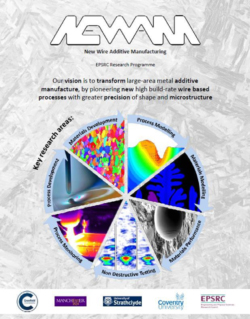21 June 2019
Cranfield University joins forces with SPI Lasers for NEWAM project
 The NEWAM (New Wire Additive Manufacturing) project builds on and exploits the UK's substantial lead in wire- based directed energy deposition (DED) technology, with a vision to transform large-area metal additive manufacture, by pioneering new high build-rate wire based processes with greater precision of shape and microstructure.
The NEWAM (New Wire Additive Manufacturing) project builds on and exploits the UK's substantial lead in wire- based directed energy deposition (DED) technology, with a vision to transform large-area metal additive manufacture, by pioneering new high build-rate wire based processes with greater precision of shape and microstructure.
To date, most of the work in wire based directed energy deposition has been carried out at Cranfield University (one of four universities (Cranfield U., U. of Manchester, Strathclyde U., and Coventry U.) that have joined forces to deliver this ambitious research program over a five year period.), who’s research over the last 10 years has proven the capability to make large titanium parts in a timely manner (weeks instead of months) and with much reduced cost (up to 70 per cent cheaper than machining from solid), resulting in a tremendous industry pull.
SPI Lasers are supporting Cranfield University in this project with their first placement of a 10kW QUBE CW Fiber Laser. The flexibility of the laser for use in the project is enhanced through the use of an integrated 4-way beam switch unit and by having beam delivery fibers of 150µm, 200µm and 400µm core diameter. To further enhance the capability of the laser processing cell at Cranfield University, two further QUBE Cabinet lasers, each of 6kW output power and with 100µm delivery fibres were also part of this project.
Professor Stewart Williams is the Principle Investigator on the NEWAM Program Grant and commented
‘We are delighted to continue our long established collaboration with SPI Lasers through the NEWAM project. NEWAM is fundamentally based around high power fibre lasers so the involvement of SPI Lasers is a very important contribution towards the success of the research program.’
Dr Mark Greenwood is CEO of SPI Lasers, and commented “SPI Lasers and Cranfield University have worked together on many development projects over the years, and we are very pleased to continue that association as we place our first 10kW QUBE CW Fiber Laser at Cranfield as part of the NEWAM project. We look forward to seeing how the results shape the manufacturing strategies of the future”.
To find out more about Cranfield University and Wire & Arc Additive Manufacturing, visit: www.cranfield.ac.uk www.waammat.com
- Contact Information
- Name: Jack Gabzdyl
- Email: jack.gabzdyl@spilasers.com
- Website: www.spilasers.com

